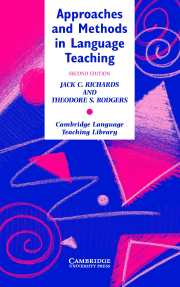Book contents
- Frontmatter
- Contents
- Preface
- Part I Major language trends in twentieth-century language teaching
- 1 A brief history of language teaching
- 2 The nature of approaches and methods in language teaching
- 3 The Oral Approach and Situational Language Teaching
- 4 The Audiolingual Method
- Part II Alternative approaches and methods
- Part III Current communicative approaches
- Author index
- Subject index
1 - A brief history of language teaching
Published online by Cambridge University Press: 06 July 2010
- Frontmatter
- Contents
- Preface
- Part I Major language trends in twentieth-century language teaching
- 1 A brief history of language teaching
- 2 The nature of approaches and methods in language teaching
- 3 The Oral Approach and Situational Language Teaching
- 4 The Audiolingual Method
- Part II Alternative approaches and methods
- Part III Current communicative approaches
- Author index
- Subject index
Summary
This chapter, in briefly reviewing the history of language teaching methods, provides a background for discussion of contemporary methods and suggests the issues we will refer to in analyzing these methods. From this historical perspective we are also able to see that the concerns that have prompted modern method innovations were similar to those that have always been at the center of discussions on how to teach foreign languages. Changes in language teaching methods throughout history have reflected recognition of changes in the kind of proficiency learners need, such as a move toward oral proficiency rather than reading comprehension as the goal of language study; they have also reflected changes in theories of the nature of language and of language learning. Kelly (1969) and Howatt (1984) have demonstrated that many current issues in language teaching are not particularly new. Today's controversies reflect contemporary responses to questions that have been asked often throughout the history of language teaching.
It has been estimated that some 60 percent of today's world population is multilingual. From both a contemporary and a historical perspective, bilingualism or multilingualism is the norm rather than the exception. It is fair, then, to say that throughout history foreign language learning has always been an important practical concern. Whereas today English is the world's most widely studied foreign language, 500 years ago it was Latin, for it was the dominant language of education, commerce, religion, and government in the Western world. In the sixteenth century, however, French, Italian, and English gained in importance as a result of political changes in Europe, and Latin gradually became displaced as a language of spoken and written communication.
- Type
- Chapter
- Information
- Approaches and Methods in Language Teaching , pp. 3 - 17Publisher: Cambridge University PressPrint publication year: 2001



